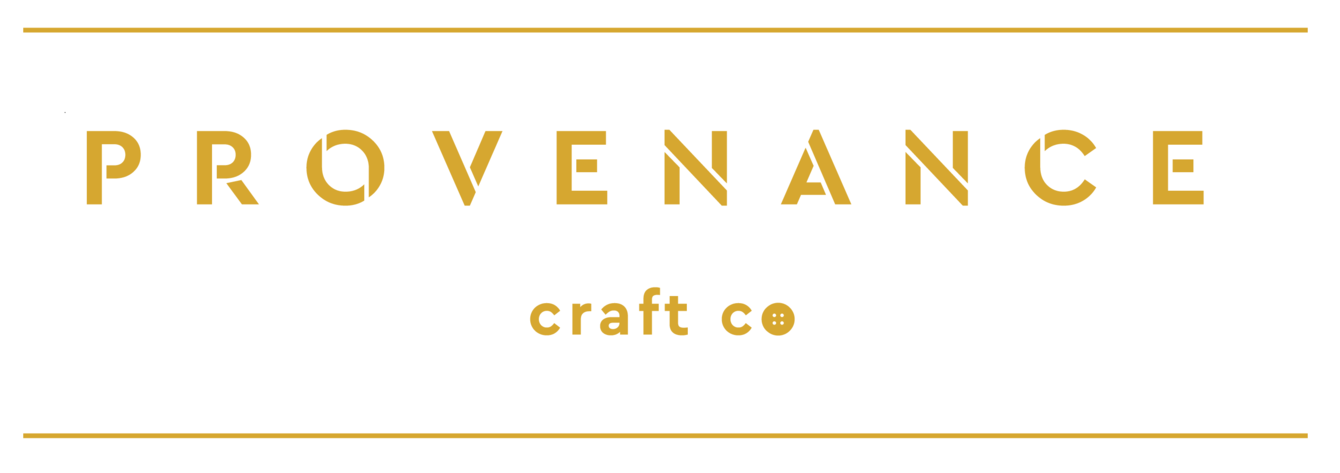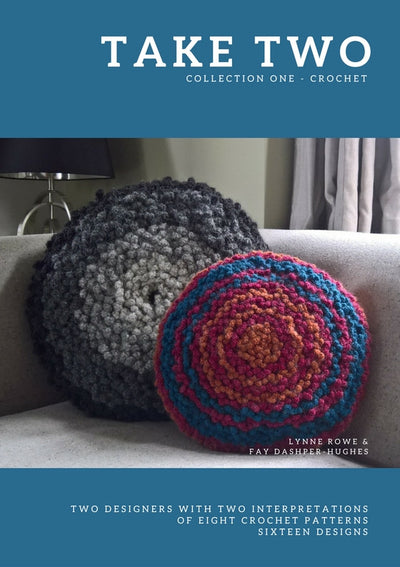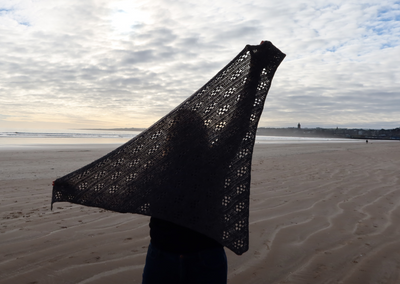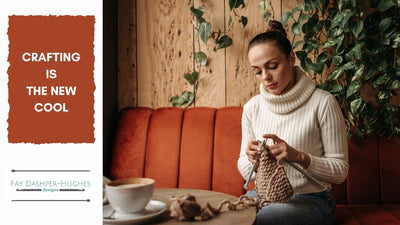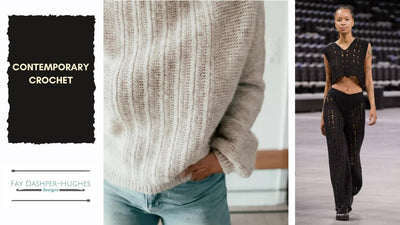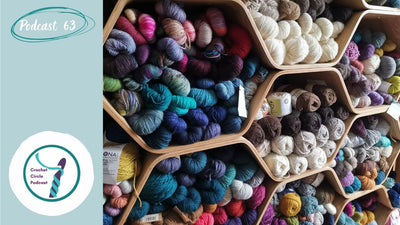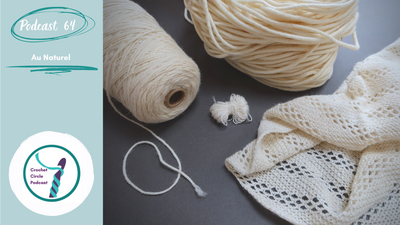
HOW TO HOLD MULTIPLE STRANDS TO MAKE A NEW HEAVIER WEIGHT YARN
About a 4 minute read
QUICK INTRODUCTION
My involvement in a Stashbusting CAL had me thinking about that annoying moment when you find a pattern you really want to make, only to go to your stash and find that you don't have the right weight of yarn.
Although my stash is sizeable (actually massive), even with a huge amount of yarn at my fingertips, sometimes I still don't have the 'right' yarn.
So, if you don't want to go out and buy more yarn, how can you get the weight of yarn you really need?
The answer is by holding two or more strands of yarn together to make a thicker/heavier weight of yarn. This isn't an exact science, but 14 swatches later, I can confirm that there are some general principles that will help you on your way.
As ever, there are some caveats because yarn is a varied beast and you need to know what you are wrangling with and I have some practical tips on the how to physically deal with multiple strands.
There will be a lot of mention of yarn weights in what follows. Whilst these are now used universally, there can be huge differences between DK or sport or 4ply from one company to the next. Regardless of what they yarn is being called, the meters/yards per 100g is what to look for and work from. Trust me when I say that a 4ply with 300m per 100g is very different from a 4ply with 450m per 100g…
If you want to learn more about yarn weights, take a look at my friend Michelle’s most excellent blog post ‘Yarn Weights Explained’ over at Dora Does.
HOW DOES IT WORK
All of the swatches I made were based on 17 rows and 24 stitches of half treble crochet (hdc in Us terms). If you happen to be reading this and you are a knitter, the same rules apply.
I tested this theory of multiple strands to get near exact meters/yards per 100g for:
4 ply (400m/437yds per 100g) using a 3mm hook
Sportweight (333m/264yds per 100g) using a 3.5mm hook
DK (250m/273yds per 100g) using a 4mm hook
Aran (200m/219yds per 100g) using a 4.5mm hook
Heavy aran (166m/182yds per 100g) using a 5mm hook
Chunky (140m/153yds per 100g) using a 6mm hook
There is no reason why you couldn't make even heavier weight yarns from multiple strands. Frankly after 13 swatches, I didn't want to make any more!

The easiest and most accurate way to create a heavier weight of yarn is to hold two strands of the same yarn together to create the exact same amount of meters/yards per 100g. For example, I created an aran weight yarn of 200m per 100g by holding together two strands of 4 ply yarn (400m per 100g). The double stranding gave me an exact match for the aran weight in terms of meters per gram (2 x 4ply (400m per 100g) gives you aran weight yarn (200m per 100g).
It doesn't have to be an exact match for meters/yards per 100g, but the closer you get, the higher the odds are on getting gauge.
Bear in mind though that if you are combining 2 x 100g skeins of 4ply to make an aran weight yarn, you will have the ability to create 200g of aran because you started with 200g of 4ply.
If your pattern only requires 100g of aran, you only need to start with 100g of 4 ply and hold it double. Throughout all of my test samples, the grams used in the multiple strand swatches were very similar to the single strand primary swatch that I was trying to match to. Keep on reading for tips on how to successfully double strand from one skein of yarn.
WHAT YARNS TO USE
A graphic free version of the infographics is available to download here.
As ever, there are caveats, so please make sure you read that section too!














CAN YOU ONLY STRAND THE SAME YARN WEIGHTS?
There is no reason why you couldn’t mix up various yarn weights to get a heavier yarn of your choice. In fact, it could be a lot of fun!
If however your are working from a pattern that has very specific gauge, you will still need to aim for the same amount of metres/yards per 100g.
Here are some examples working from the infographics above:
- 2 strands of 800m per 100g heavy laceweight = 400m per 100g 4ply. Therefore, 2 strands of 800m per 100g heavy laceweight + 1 strand of 400m per 100g 4 ply = 200m per 100g aran weight yarn.
- 2 strands of 700m per 100g heavy laceweight = 350m per 100g. Therefore, 2 strands of 700m per 100g heavy laceweight + 1 strand of 350m per 100g heavy sportweight yarn = 175m per 100g heavy aran weight yarn.
PHYSICALLY CREATING MULTIPLE STRANDS
1 – This is definitely a messier way of working. You will likely be working from multiple balls of yarn and this can create higher or lower twists in the yarn and strand bunching.
2 – If your project only requires 100g from the same yarn weight (like 2 strands of 400m 4ply to make 200m per 100g aran weight yarn) then there are two approaches:
Weigh the yarn, ball up half of it and cut the yarn. Ball up the second half. The downside to this is that if you don’t use all the yarn, it is now split into two balls.
Using a swift and ball winder, cake up the skein. When you take it off the wonder, make sure you hold onto the starting strand in the middle. You can now hold the strand from the centre with the strand from the outside to hold them double.
If you are working from a hank of yarn, you may find it easier to use the method from bullet point 1. The yarn barf inside hanks of wool can be very frustrating!
3 – If you are pulling together lots of yarn strands, it may be easier to pull all the strands together into one large ball. This will make it easier to store and work from. I would only use this method if all o most of the resulting ball of yarn is going to be used in your chosen project. Otherwise you have a ball of leftover multiple strands of yarn that may never be used.
4 – Now I haven’t tested this yet, but I suspect that if you are bringing multiple strands together of the same yarn, from the same manufacturer, you could open the multiple skeins and carefully place them on a swift on top of each other. By making sure the skein ends are at the same point on the swift, you could then ball multiple strands together in one go. If you try this out, please let me know how you get on. Disclaimer: I am by no means responsible for the yarn spaghetti this may create! 😊
CAVEATS
As with all things woolly, there are caveats with using multiple strands held together:
1 – You still need to swatch. This is an ugly truth of crochet and knitting. Swatching is what delivers the best results and it’s even more important if you are holding multiple strands together. Short cuts are tempting but extremely annoying when a 40 hour project isn’t quite right because the swatching was skipped!
2 – Yarn blend has a huge impact on the final gauge of your fabric. A silk/wool blend with create different gauge from an acrylic/wool blend. Swatching is key.
3 – The way the yarn was manufactured will impact on gauge. If the yarn you are trying to recreate was worsted spun, try to use worsted spun for your strand multiples. The same applies to woollen spun and roving yarns, they all react differently because of how they are manufactured. Again, swatching is key.
4 – If you are using a very colourful strand with a quieter strand, the overall fabric will be quieter because you are reducing the colour noise. If you want high colour contrast, choose your strands wisely. This works the other way too. You may have a yarn that you bought back in the day when you loved all things rainbow unicorn and it’s no longer your thing. The rainbow unicorn can be partially tamed by introducing a solid neutral strand such as a grey or cream.
5 – Because the strands are only being held and not plied together, it is noticeable in your finished fabric. The more strands you use, the more noticeable it is. I don’t dislike the resulting effect at all and actually rather like the way the 5 strands of heavy laceweight yarn used to make a chunky weight give extra texture to the finished fabric.

This swatch shows 5 strands of heavy laceweight held together to make a chunky weight yarn. The strands are obvious, but I quite like that.
LET'S KEEP IN TOUCH
It would be lovely to hear from you on Instagram or Pinterest. I also have a monthly newsletter which you can sign up for below.
About Fay Dashper-Hughes

My name is Fay and I design crochet and knitwear patterns. I love proper woolly wool and showing crochet off for the beautiful, versatile craft that it actually is. Inspired by nature, architecture, Scottish landscapes and British wool.
Generally found in my happy place, my craft studio, affectionately known as The Hive.
